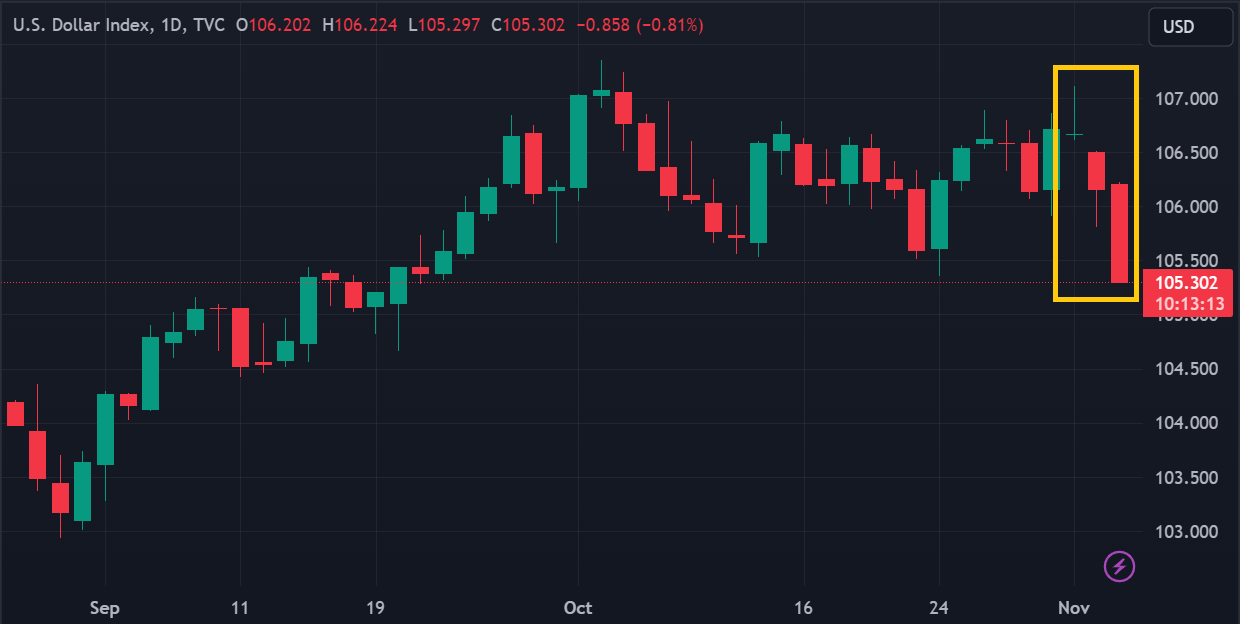The US Dollar was hit by more than 1 percent against the Aussie and Kiwi due to the release of NFP data, while EURUSD and GBPUSD surged instantly.
The latest set of US labor reports collectively fell short of market expectations and weakened compared to the previous period, including the Nonfarm Payroll (NFP) data. As a result, the US Dollar Index (DXY) tumbled significantly to around 105.30 in the New York session on Friday, November 3rd.

US Nonfarm Payroll data only increased by 150k in October 2023, whereas the previous consensus had expected 180k. September 2023 data was also revised down from 336k to 297k.
The US unemployment rate rose from 3.8% to 3.9%, while the Labor Force Participation Rate dipped slightly from 62.8% to 62.7%. Average Hourly Earnings data grew by only 0.2%, weaker than the expected 0.3% growth anticipated by market participants.
Reuters reported that these figures might have been affected by the strike organized by the United Auto Workers (UAW) against the three largest automotive manufacturers in Detroit, even though the actual US labor market conditions remain tight. Nonetheless, this data still supports speculation about the end of the Fed's interest rate hike cycle.
"The hiring figures will ultimately be somewhat depressed by strike activity, though the labor market is still likely to remain quite tight," said Sam Bullard, a senior economist at Wells Fargo in Charlotte, North Carolina.
Yohay Elam from FXStreet also believes that this data reinforces the end of the interest rate hike cycle, which is hurting the US dollar. At the same time, he sees the data as presenting a "perfect" scenario for stocks. Equally important, Elam notes that the trends supporting bond buying remain strong, pushing yields down.
The US dollar was immediately hit by over 1% against the Australian and New Zealand dollars following the release of the NFP data. EUR/USD and GBP/USD surged by almost 1%. Meanwhile, USD/JPY dropped back to the 149.30s. The greenback's decline paused momentarily as of the time of this writing, while market participants are awaiting the release of the ISM version of US Non-Manufacturing PMI data.

 Dedicated FREE FOREX VPS
Dedicated FREE FOREX VPS Free FOREX Virtual Private Server
Free FOREX Virtual Private Server MT4 Demo Contest, Get $500
MT4 Demo Contest, Get $500 Sign Up for an Account, Claim 60% Deposit Bonus
Sign Up for an Account, Claim 60% Deposit Bonus Free MT4/MT5 VPS 2024
Free MT4/MT5 VPS 2024 Send E-mail and Get Free Merchandise
Send E-mail and Get Free Merchandise $1K Refer a Friend Bonus for Pepperstone Pro clients
$1K Refer a Friend Bonus for Pepperstone Pro clients Maximize Your Earnings with 100% Deposit bonus
Maximize Your Earnings with 100% Deposit bonus Trade to Win, $5,000 Monthly Demo Contest
Trade to Win, $5,000 Monthly Demo Contest Claim 30% + 15% Deposit Bonus from LiteFinance
Claim 30% + 15% Deposit Bonus from LiteFinance






